Have you looked at the night sky during the last few nights and thought, “Wow, that moon looks … super?” Between Nov. 13-15, you weren’t alone and you weren’t wrong!
On those nights, the moon was as close as possible to Earth in its orbit in a position called the perigee, and appeared bigger and brighter than it has in 69 years. It won’t be that big and bright again until 2034.
A giant bright moon is pretty and fun for astronomers — but why should the everyday Earthling care?
As the moon and the tides are intertwined due to gravitational forces, we can expect to see and hear about a lot of tidal changes around the world. This is important for geologists and environmentalists because Earth is nearly 70 per cent covered in water, thus major changes in tidal ecosystems can impact a large chunk of the planet.
NASA lunar specialist Noah Petro commented on the supermoon’s affect on the planet.
“One of the interesting things about the moon is that it’s not only pulling on the Earth’s oceans, it’s actually pulling on the Earth’s crust,” Petro said. “The Earth’s crust — the land beneath our feet — actually deforms and responds to the moon in a very subtle way.”
For viewing the moon on any night, supermoon or otherwise, follow these tips from the Gustav Bakos Observatory on campus. “The moon is up all night so all you really need to be concerned about is clear skies,” recommended observatory co-ordinator Victor Arora. “The moon will rise at sunset and although it looks gigantic on the horizon, this is just a pleasing optical illusion.” For getting a close-up look, Arora had a few recommendations. “Using binoculars will greatly enhance your viewing experience and even small telescopes can show intimate details of the moon, like craters.”
NASA’s tips for capturing Earth’s favourite hunk of rock:
- Photograph the moon with a land object to provide reference for size.
- Do your research, you may have to scout locations to avoid light pollution.
- Smartphones will do OK. Use your panoramic setting to catch a more full photo.
- Don’t forget the moon is moving! You may need to adjust your shutter speed and exposure to get the perfect shot.


































